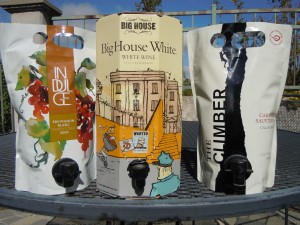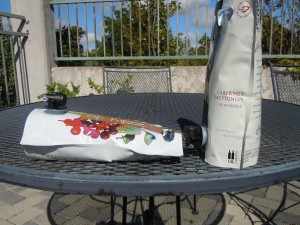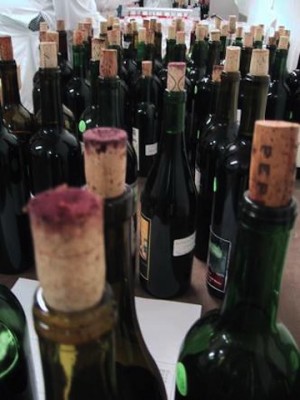 Wine in a bag? Surely you’ve seen wine in a box. You probably equate that with plonk. But times are changing when it comes to wine in a bag, box or vessel other than glass. With Memorial Day weekend ushering in a season of outdoor BBQ and picnics, why not try one of these modern alternatives to the traditional glass wine bottle.
Wine in a bag? Surely you’ve seen wine in a box. You probably equate that with plonk. But times are changing when it comes to wine in a bag, box or vessel other than glass. With Memorial Day weekend ushering in a season of outdoor BBQ and picnics, why not try one of these modern alternatives to the traditional glass wine bottle.
Wine in a Bag
Recently, a package landed on my doorstep containing samples, two bags of wines. They look like the bags used for IV drips in the hospital. You know how people say, hook me up to an IV of wine? The samples came from Clif Family Winery, creators of Clif Bars. Each bag, or pouch, as Clif calls them, holds two bottles of wine (1.5 liters – a magnum). They are filled with The Climber wines, Chardonnay and Cabernet Sauvignon. Both carry the California appellation and are non-vintage. Clif Wines says although this first release is from the 2009 vintage, that going forward, the wines may be multi-vintage blends.
Clif’s first release of the wine pouch was on Earth Day in April. On the back of the bag, there’s a list of why this packaging is green: 80% lower carbon footprint, 90% less waste and lighter to carry. The pouch bag is also resealable (there’s a plastic tap) and should last up to a month after opening. It’s also light and easy to carry around (has built in handles), won’t break, won’t have cork taint and takes up a lot less room in the refrigerator. You can take this on your bike or on a hike. About the only place the pouch can’t go is on a plane in your carry on bag.
How does the wine taste?
I am able to compare Clif’s wines to another wine in bag, thanks to a separate sample that came my way from Indulge Wines. Indulge is a new wine label, created specifically for packaging wine in these bags, which they call an AstraPouch, for the company that developed this technology. The two Indulge wines are a 2009 North Coast Sauvignon Blanc and a 2009 Central Coast Pinot Noir.
One advantage that’s touted about the pouch is you can chill it much faster than wine in a bottle, in 14 minutes. I tested that out, tossing the bag into my fridge. After 14 minutes the wine’s temperature was a little warm to me. As for the wines, it’s not a fair comparison since the varietals are all different. What they all have in common is being a fresh, fruity wine. The Indulge Sauv Blanc is zippy and crisp, with citrus, as you’d expect. The Climber Chard has apple and tropical notes, The Climber Cab has cassis and blackberry, with a hint of vanilla from oak. All perfectly drinkable, enjoyable wines. My least favorite is the Indulge Pinot, which I find flat and a little bitter. A pouch of Clif’s Climber wines is $17; a pouch of Induge Wines is $20.
Wine in a Box
Box wine is a term that’s a little misleading. The wine isn’t exactly in a box; it’s in a bag or what’s called a plastic bladder, which is inside that box, and it has a plastic tap for dispensing wine. The bag-in-box was created in the mid 1960’s in Australia. Today, some producers call their wine boxes casks, an attempt to convey a classier image than the one associated with wine in a box.
A glass wine bottle is not the greenest product. It’s heavy and takes up a lot of room for shipping and storing. Many wineries are looking at their carbon footprint and deciding to lower it with glass bottle alternatives. The bag-in-box can hold the equivalent of 4 bottles of wine (20 glasses), reducing the packaging and shipping costs to wineries.
For you and me, there are lots of advantages to buying wine in a box. The biggest is that wine lasts much longer in a bag than in a bottle, because the plastic bladder keeps air away from wine. The wine is packaged under vacuum, and as you empty the wine into your glass, the bag collapses in on itself, keeping the wine fresh for up to six weeks. I’ve yet to drink a wine that’s been in the box for six weeks (we drink it a lot faster than that), but I can tell you that after a few days, and even two weeks, that the wine is still fresh and lively. No more worrying about finishing the bottle of wine you’ve opened for dinner and having it go bad in a day or two. Put the white wine box in the fridge, and you’ve got chilled wine on tap when you want it.
Wine in a box is not glass, and that means you can drop it without breaking it. You can also take the box wine to places that allow alcoholic beverages but not glass bottles.
Because there are four bottles of wine in the box, you don’t need as much room in your wine cellar (or closet or pantry) to store it. It’s a great party wine, since you get more wine for your money, and you don’t have to keep opening bottles (most box wines I see are around $20 or less). Since there’s no cork, you don’t have to worry about the wine being corked.
As I see it, there are two downsides to box wine. One is that it’s not the best container for laying down wine, since no air gets to it in the bag. A glass bottle does allow a very small amount of oxygen in over time, which helps in the aging process. So you’re probably not going to find a high end Cabernet Sauvignon or Pinot Noir packaged this way. Box wines are meant to be drunk sooner rather than later, and some boxes even have a “drink by” date.
No longer plonk inside box
The other downside has been what’s in the bag. But now, some very good wines are going into the bag-in-box. I like 2010 Big House White, a brand that was once part of Bonny Doon Vineyard, but is now part of Underdog Wine Merchants. Big House White comes in a box, but it’s still available in a 750 ml glass bottle. This makes comparing bottle vs. box easy. The two wines taste the same, and the wine in the box stayed fresher much longer. Box wine has come a long way, and you can find a wide range of varietals from all over the world sold in boxes. Prices range from less than $20 to $40. Keep in mind that you get four bottles of wine in one box, and most boxes cost less than you’d pay for the four glass bottles.
Can’t bring yourself to buy a bag or box of wine? Get over it. You’re going to see more of these alternatives to glass bottles, including tetra paks (think juice carton) in single or multi-serving sizes, and producers are even experimenting with plastic bottles. It just makes sense, with the packaging and transportation costs savings to wineries and with being environmentally and consumer friendly. As long as the taste is there, and the quality of wine continues to get better, there’s no reason not to buy and drink wine packaged in a box or a bag, and be proud of it.



3 Comments
A couple of comments from someone that works on developing alternative packaging with wineries: they are not meant to age, as plastic is not a hermetic seal. Air does slowly “seep” through the plastic bags. Most bags and pouches have a layer sandwiched between outer layers that is a barrier that traps oxygen until it is fully saturated, hence the “drink by” dates are necessary. It is true that the wine inside a bag-in-box lasts longer once it has been opened than it does in an open bottle, but a sealed glass bottle will always be the way to age a wine. Also, FYI a sealed bottle with a proper cork will not allow any air in; the oxygen trapped in the neck during bottling is what interacts with a wine during the aging process.
Totally agree that these are exciting new packages that will make wine more accessible to people! Thank you for the article.
Paul, thanks for adding your expertise on this.
Pingback: Wine in a Bag - Don’t Laugh - The Quality Might Surprise You